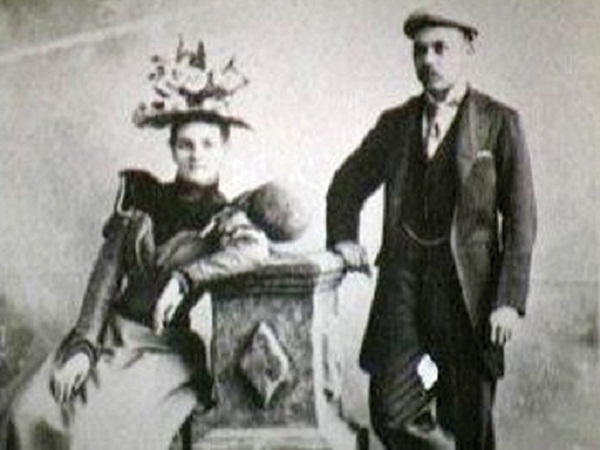
JOSEPHINE and Vicente: A photo of the newlywed Josephine Bracken-Abad and Vicente Abad in Hong Kong. Photo from brackenjosephine.blogspot.com
Despite its unhappy ending, the story of Jose Rizal and Josephine Bracken is one of the best known in Philippine history.
It remains so simply because their marriage has been the subject of debate simmering for the past 120 years.
Whether or not Rizal married his live-in partner shortly before his execution in Bagumbayan is a question inseparable from the issue of his retraction from religious error.
Most sentimental relic
While historians argue, many visitors will flock to the National Museum to gaze at what is perhaps the most personal, the most sentimental of Rizal relics—a 19th-century Spanish edition of the devotional classic “The Imitation of Christ” by Thomas à Kempis.
We do not know if the national hero read the book or not, whether he drew spiritual comfort from it during his last hours in his Fort Santiago prison cell.
But what makes this ordinary book extraordinary is an inscription on the flyleaf that reads: “To my dear and unhappy wife Josephine. December 30th 1896. Jose Rizal.”
This small leatherbound book measures 14.5 by 8.5 centimeters, and carries the kilometric Spanish title: De la Imitacion de Cristo y Menosprecio del Mundo por el V. Tomas de Kempis. Traduccion del Latin por P. Juan Eusebio Nieremberg de la Compania de Jesus enriquecida con varias e interesantes adiciones por el Ilmo Sr. Dr. D Antonio Estallela Obispo de Teruel. Con licenica del ordinario Cuarta edicion Barcelona Imp. Y Libreria de Subirana Hermanos Calle de la Puertaferrisa, Num 13. 1895 [On the imitation of Christ and contempt for the world by Thomas à Kempis. Translated from the original Latin by Fr. Juan Eusebio Nieremberg of the Society of Jesus and enriched by various and interesting additions by the Illustrious Antonio Estallela, Bishop of Teruel … Fourth edition Barcelona Libreria Subirana Brothers … 1895].
Coded message?
Aside from the inscription, there are faint markings on the table of contents at the end of the book, crosses and underlined text that await further research to determine if these are by Rizal or not, if these markings are yet another coded message or not.
Sometime in the mid-1980s, the book was offered to the government for purchase through the late Serafin D. Quiason, then chair and executive director of the National Historical Institute (NHI) by the heirs of a certain Silvino Dayco who acquired it from the husband of Bracken’s adopted daughter, Dolores Abad de Mina, sometime before World War II.
Emilio Aguilar Cruz, senior member of the NHI board, confirmed its authenticity after a thorough examination, since it was supported by a letter from National Library Director Teodoro M. Kalaw thanking Dayco for lending the book for an exhibition in the Library before the war.
Unfortunately, government funds were not available to purchase the book at the time so it went missing for almost three decades until it resurfaced a few weeks ago when its present owner, Patrick Eugenio, donated it to the National Museum, on condition that it be permanently displayed for the enjoyment and education of the public.
Aside from the Kempis in the National Museum, the other physical clue to the Rizal-Bracken marriage is a handwritten autobiography preserved in the Lopez Museum where Bracken concludes with a declaration that “Before his execution, he married me at 5 o’clock in the morning.”
In this document, whose authenticity has been questioned, she signed herself “Josephine Bracken de Rizal, a widow.”
To dispute these, letters by Rizal have been presented to prove he never referred to her as his wife but rather as Josephine, Miss Josephine, Miss J or Miss B.
‘Dulce estrangera’
In the manuscript of Rizal’s valedictory poem, “Ultimo Adios,” kept in the vault of the National Library, Josephine is immortalized in the second to the last line, which reads: “Adios dulce extrangera, mi amiga, mi alegria (Farewell sweet foreigner, my darling, my delight).”
But the poem was written out, in its final form, and hidden in a small metal cooking stove on Dec. 29, 1896, and the marriage occurred in the early morning of Dec. 30.
While historians argue, Rizal left us with no doubt regarding his affection for Bracken.
In a letter dated March 14, 1895, Rizal introduced Bracken to his mother in Manila as follows:
“Bearer is Miss Josephine Leopoldine Taufer, with whom I was on the point of marrying, relying, of course, on your consent. Our relationship was broken as proposed by her, because there were many difficulties on the way. She is almost entirely an orphan. She has no relatives except very distant ones.
“As I am interested in her and it is very easy for her to decide later whether to marry me, and as she is liable to be left entirely alone and abandoned, I am asking you to extend her hospitality there, treating her as a daughter until she has a better opportunity or occasion to come back … Please treat Miss Josephine as a person whom I esteem and much appreciate, and whom I would not like to see exposed and abandoned.”
In one of the last letters to his family, Rizal left specific instructions on where and how he wanted to be buried.
He closed this letter with an appeal: “Tened compassion a la pobre Josefina [Have pity on poor Josephine].”
Two hours before he calmly walked to Bagumbayan for his appointment with destiny, Rizal left a small souvenir, a book dedicated to his “dear and unhappy wife Josephine.”